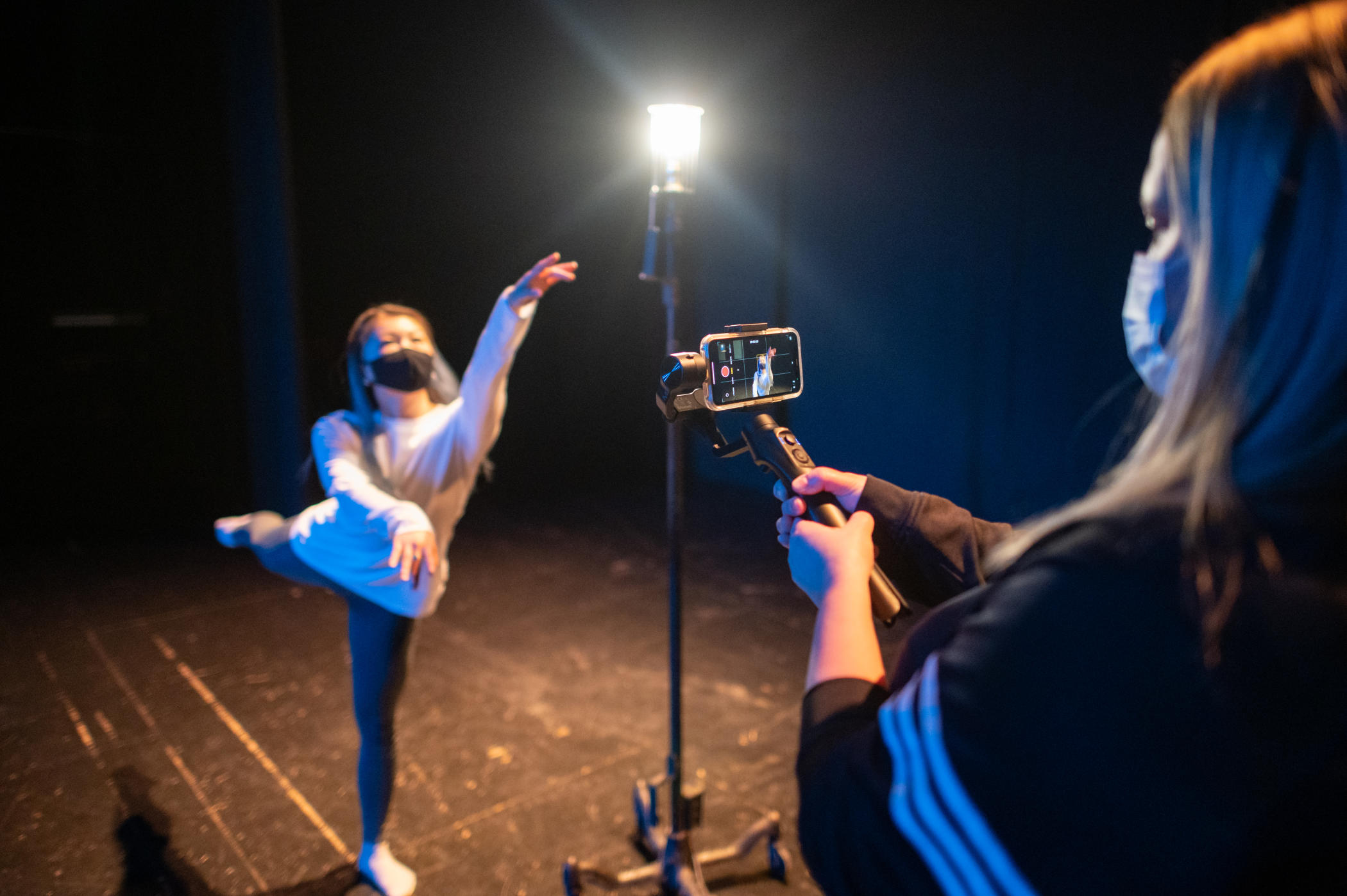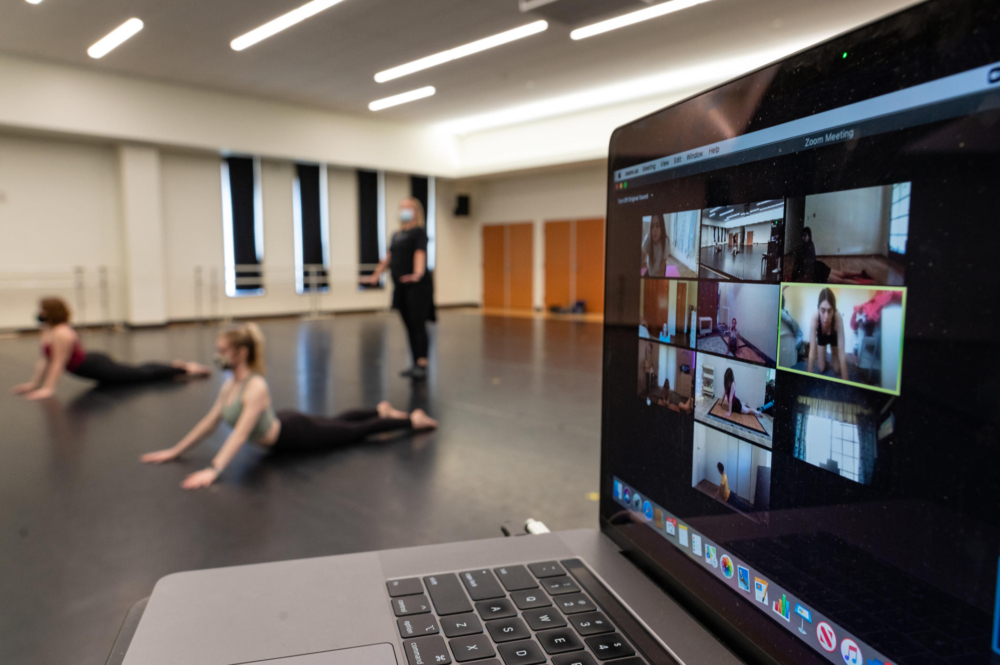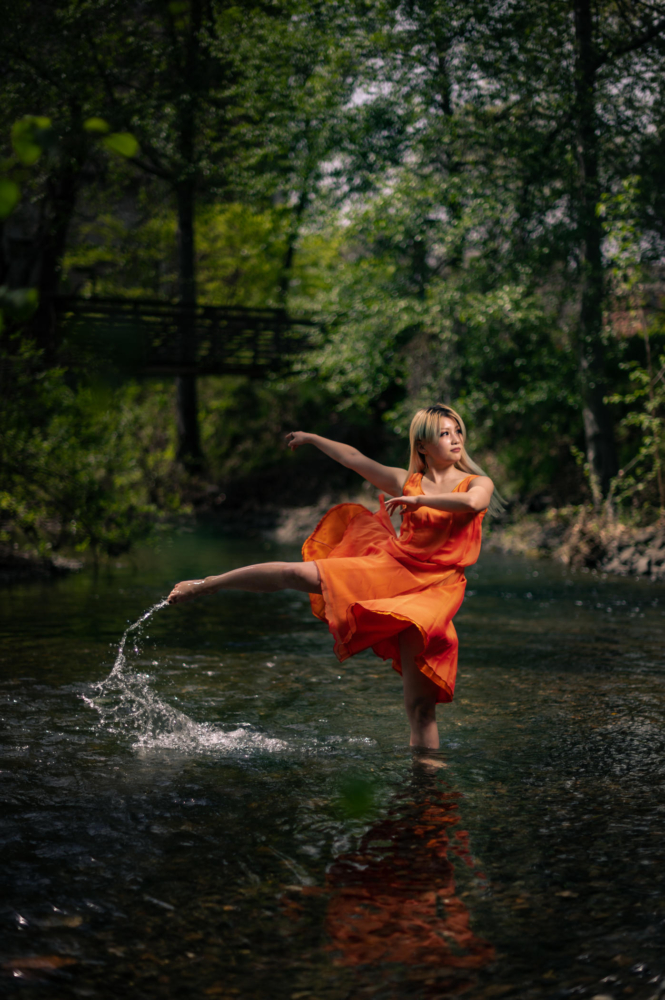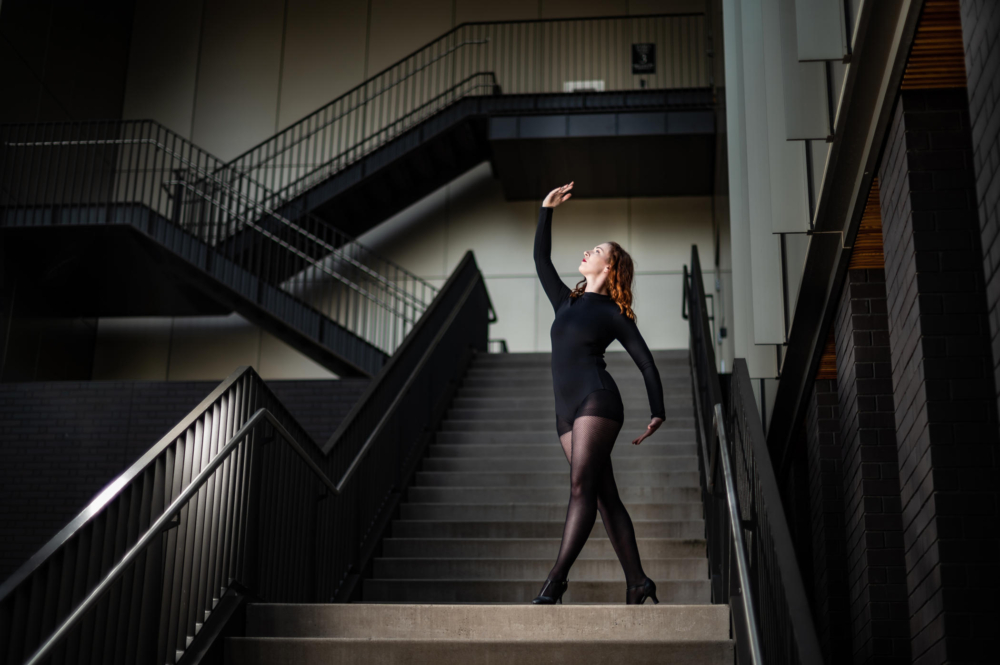Dance Students Rediscover Groove in Virtual Collaboration

Dance, Theatre Assistant Professor Megan Glynn Zollinger (right) records a video of Natsumi Kawamura (left) who performs a dance routine amongst a ghost light in the Rowland Taylor Recital Hall on Friday, November 20, 2020 in Chico, Calif. A ghost light is a single bulb left burning whenever a theatre is dark. (Jason Halley/University Photographer/CSU, Chico)
Story by Lorie Parch
When senior Natsumi Kawamura takes the stage for her solo in “THEN:NOW:WHEN,” her lithe, supple movements immediately draw in the viewer, almost as if she were standing before you. But she’s not.
Kawamura’s performance is part of the CSU Dance Collective’s third virtual dance concert, “In [This] Space,” which debuted in fall 2020. These days, if you want to see the musical theatre major dance, you’ll need to watch her online.
While there’s no substitute for a live performance—the energy of the crowd and all eyes turned toward the stage in anticipation of an experience that can only happen in this moment—the pandemic changed how dancers could perform. It didn’t, though, stop faculty and students from reimagining their classes and performances in ways neither could have guessed.
“I was a little bit scared about putting my creativity into a camera and on a screen,” Kawamura said. “I was thinking the virtual dance concert would just be a dance movie, but we realized we could collaborate with artists, painters, and musicians and make the piece more creative and more beautiful. . . . It gave me more ideas and expanded my creativity.”
The experience, junior Raymundo Ballejos, Jr. agreed, was revolutionary.
“‘In [This] Space,’ as a whole, when it was complete, changed my experience on dance in the online format. Without being forced to go online, moments such as creating a new dance piece or creating a massive dance collective aren’t thought of without the obstacle of a pandemic,” he said. “Having the time to recognize how we can seize this moment and still create art has been the experience of a lifetime.”
Collaborating Across the CSU
The three virtual dance performances that took place in November and December 2020 were the first for the CSU Dance Collective, the brainchild of Megan Glynn Zollinger, an assistant professor of dance at Chico State, and Heather Castillo, an associate professor of performing arts at CSU, Channel Islands. The collective now includes 20 CSU campuses.
What started as a challenge to teach online something inherently physical, immediate, and experiential has become a tremendous opportunity.
“Keeping it virtual means that more people can be involved from all over,” said Zollinger, who is also the dance program coordinator. “We meet bi-weekly and are holding a concert once every semester, and we’d like to cross-collaborate to teach master classes at different campuses. . . . Even when we go back to having things in person, a lot of this virtual work will continue.”

For the concert, each campus had the freedom to create a single contribution or several, for a total of no more than 12 minutes. Most used class time to develop their choreography, and, where funding and skill allowed, applied expert video editing, original music, or graphics. Other students shot their performances entirely on smartphones.
The collaboration offered a unique learning moment no one anticipated.
“Without the live audience, it allowed the participating schools to be the audience and appreciate one another’s hard work in an intimate way,” said Ballejos, whose first online performance was the fall event. “The experience allowed for a more personal attachment to the material while getting a wider look at what other schools are creating.”
All the World’s a Stage
This is not to say that learning—or teaching—dance has been easy or simple during the pandemic. Thrown into Zoom classes last spring, Zollinger scrambled as much as any other instructor to adapt.
“We still met synchronously, we just had to shift to [tap-dancing] on a piece of plywood and moving furniture around,” she said, stressing that safety was always paramount. Some choreography had to change, too; turns and more complex movements wouldn’t work for many. “We needed to figure out how to do a movement in class when someone only has four feet of space.”
Junior Amaya Barcus found it tough to adjust in COVID-19’s early days.
“There’s a vibe or feeling when you walk into a studio or theater and you’re around all these people,” she said. “There was a transition to figure that out when you’re in your living room or kitchen.”
Barcus, who was taking intermediate tap, invested in a tap board to avoid denting the linoleum in her kitchen.
“I live in an upstairs apartment, and I had to apologize to all my neighbors,” she said with a laugh. “A lot of the tricks and movements that we could rehearse in studio space on campus aren’t feasible for a lot of people now.”
Many of the pieces in “In [This] Space” feature students outside, allowing them to remain safely distanced from one another while incorporating what’s around them as they move.

“I was so impressed with the different environments they selected and the rawness of them,” said Zollinger. “In one, it was right after another set of fires up here. . . . They were literally dancing with red sun and ashes blowing around. It said, ‘This is Chico at this moment, but we still love it.’ It was really beautiful.”
For dance faculty and students alike, the shift has been profound. Many have gone from seeing constrained movement at home as limiting and isolating to an embrace of all that they could do, in spite of COVID-19, that they’d never considered before
“Having the chance to see many different styles of dance in many different places opened my eyes to where dance can and should take place,” said Ballejos. “The world is most definitely, without a doubt, your stage.”
Dancing with Myself
That’s exactly the attitude Zollinger hoped for. A longtime champion of the values of dance, she led efforts to reinstate the dance minor at Chico State starting with fall 2020, a program she sees as tapping into what was already a strong student-driven devotion to dance.
“Chico is very remote, and without a dance program the students really took [dance] into their own hands,” said Zollinger. “They created their own shows, ballroom clubs, dance teams, hip-hop. I saw a huge desire to create a very strong dance minor that’s accessible to anyone, no matter what they study.”
Drawing on faculty from kinesiology, theatre, and art, the professor brings in guest artists and strives to support the University’s musical theatre program while serving all dancers, regardless of style, genre, ability, or body type. Today, 25 students are now minoring in dance.

Watch the CSU Dance Collective’s Spring Virtual Dance Concert at 7 p.m. on April 30, May 7, and May 14 on their website. There you’ll also find links to watch the three fall 2020 programs.
Lorie Parch has been a journalist and editor for 30 years. For the last five years, she has been covering higher education, with a special focus on the California State University system.


